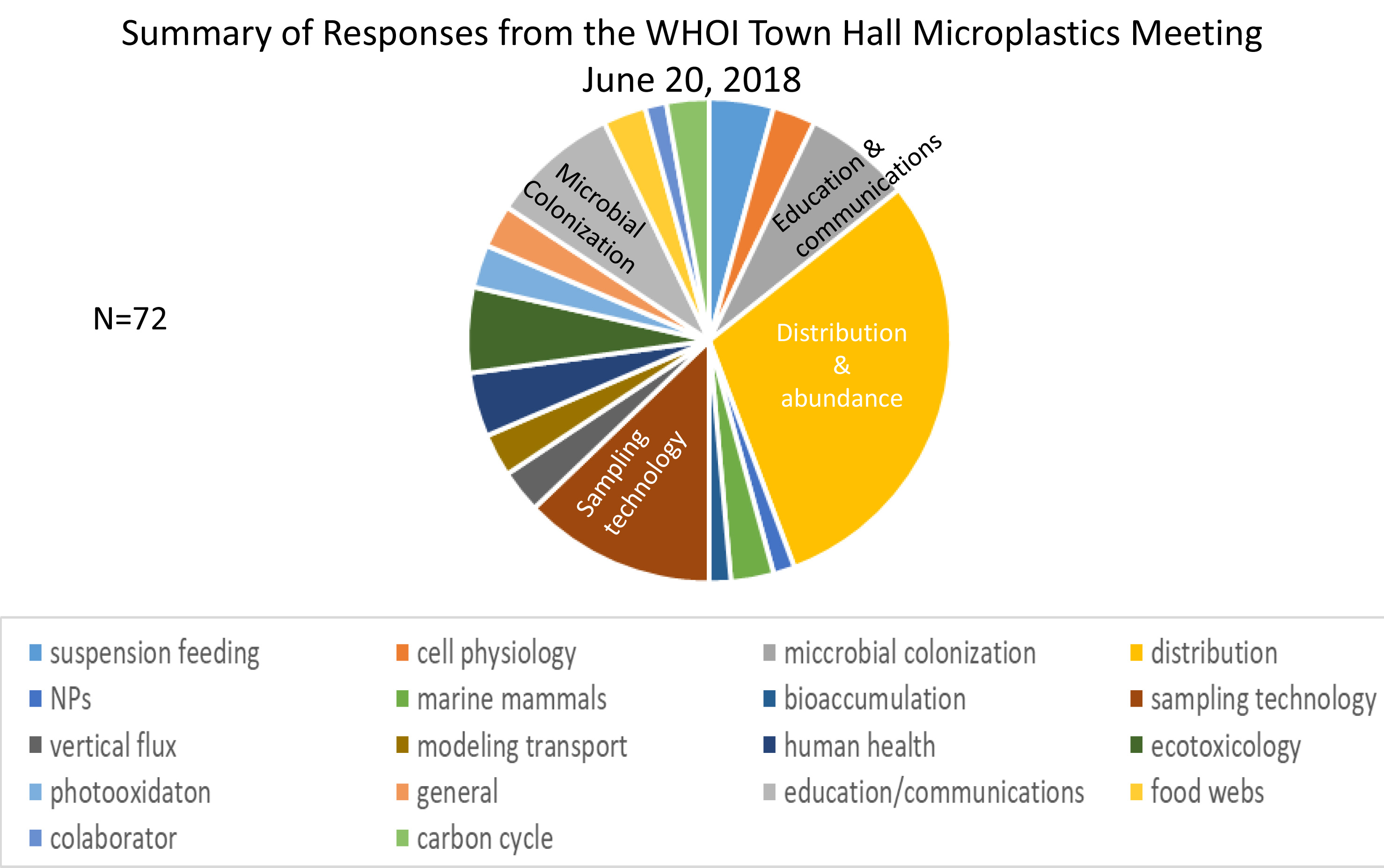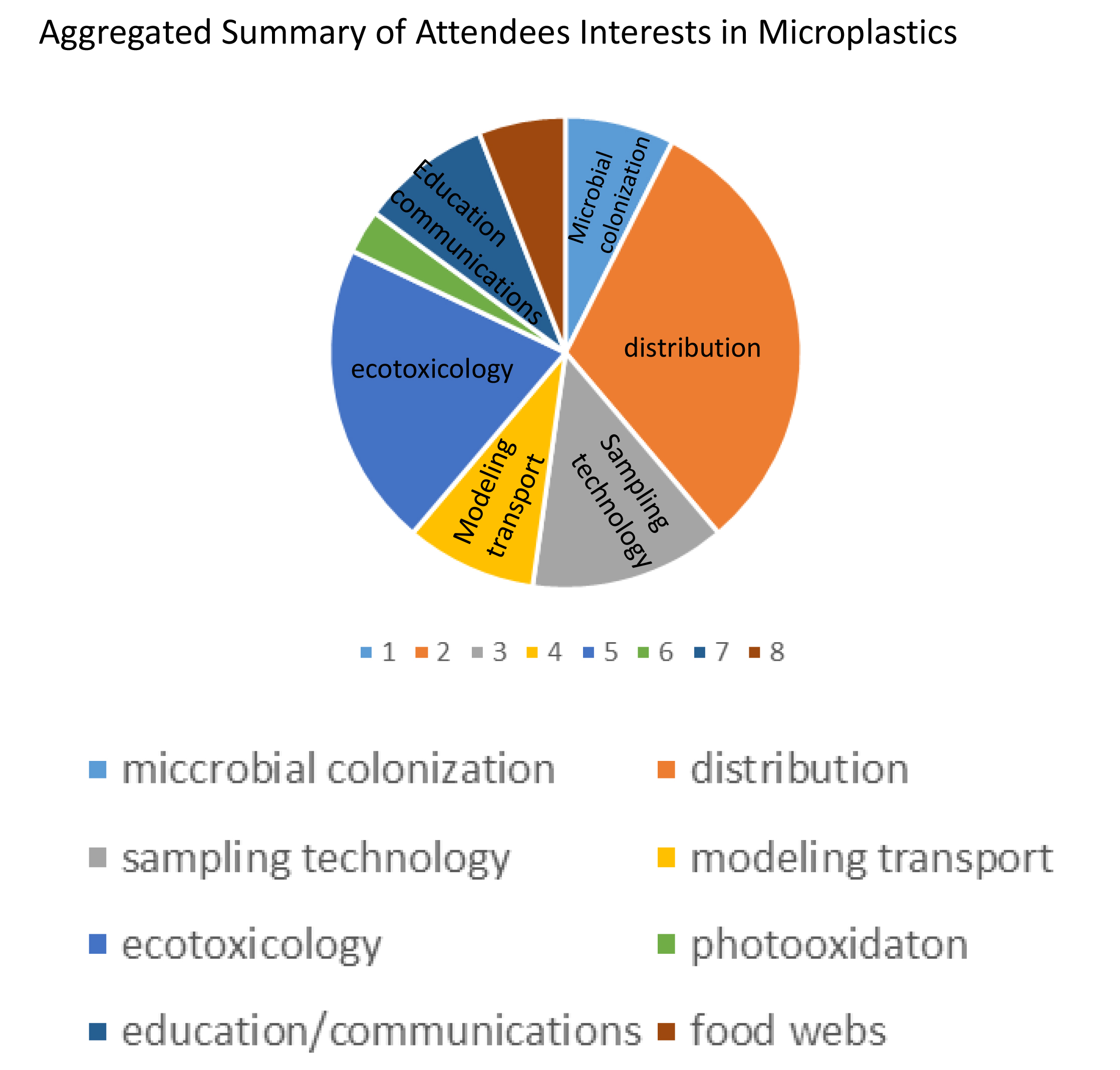Report on the WHOI Science of Microplastics Town Hall Meeting
Wednesday, June 20, 2018, 1-3 p.m.
Clark 507
Over 60 scientists, engineers, technicians, stock assessment managers, and other members of the Woods Hole scientific community met on June 20, 2018 to discuss the issues associated with microplastics (MPs) in the world ocean. The WHOI MP Catalyst Team presented their Phase I research plan in a series of short (5 to 15 minute) talks. A discussion was encouraged throughout the meeting on what are the major issues to be addressed in a Phase II follow-on proposal. This was followed by eight 5-minute lightning presentations by members of the community who brought their experiences and research goals to the table as part of a holistic discussion on what WHOI could and should be doing about MPs from an oceanographic perspective.
Catalyst Team Presentations
Scott Gallager, Chair. Overview of the issues and what is known and unknown. Research on MPs started at WHOI in 1972 when Ed Carpenter published two papers in the Journal Science on MPs in the Sargasso Sea. The lack of standards and best practices is hampering the way forward in MP research.
[Video Presentation]
Chris Reddy. Let’s treat plastics just like another fraction of the global carbon cycle.
[Video Presentation]
Jake Gebbie. Can microplastics constrain ocean mixing and circulation? If we can identify distribution, rates of breakdown, possible source locations, can we back out advection and mixing across multiple scales? This will require multiple scales of modeling, from microscale to mesoscale to basin scale.
[Video Presentation]
Anna Michel. Need for advanced technology. Looking for MPs is a needle in a haystack so we need high volume processing to classify plastic particles. FTIR and Raman spectroscopy have promise to detect MPs fast.
[Video Presentation]
Amy Appril / Shavonna Bent. Microbes and microplastics. Who’s there? What are they doing (functional genes), How are communities organized (imaging), Transfer of cells from plastics to animal hosts.
[Video Presentation]
Mark Hahn. Ecological and human health impacts of microplastics. We need both Hazard Assessment and Exposure Assessment to understand the Human Health Risk Assessment. What is the bioavailability of MP-adsorbed contaminants to humans?
[Video Presentation]
Hauke Kite-Powell. Policy questions. What are the risks and costs associated with human health effects?
[Video Presentation]
At this time, we went around the room as asked members of the audience to come up and provide 5-minute lightening presentations of their own interests and work.
5 Minute Lightening Talks
Kara Lavender-Law/ Jessica Donahue, Sea Education Association- Measuring Plastics at the Sea Surface. Extensive 11 year data set on MPs in the North Atlantic. Density dependent rise velocities (0.5 to 4 cm s-1).
[Slides | Video Presentation]
Dana Yoerger, WHOI. New technology for the search for microplastics in the mesopelagic zone: The mesobot. We should be able to add spectrometry technology to mesobot to characterize MPs.
[Slides | Video Presentation]
Houshuo Jiang, WHOI. Suspension feeding dynamics and microplastics uptake by ciliates. Favella can effectively reject plastics by reversal of their cilia.
[Slides | Video Presentation]
Dror Angel, University of Haifa. Microplastic research in the Mediterranean. Ingestion of MPs by sea turtles, jellies, and fish.
[Slides | Video Presentation]
Colleen Hansel, WHOI. Biogenic Production of Extracellular Reactive Oxygen Species (ROS): Role in Microplastic Degradation? Widespread production of superoxides by bacteria and algae. Could MPs be oxidized by these superoxides?
[Slides | Video Presentation]
Ankur Shah, University of Alabama Huntsville. WHOI’s Societal Impacts.
[Slides | Video Presentation]
Chris Noble, MIT Environmental Solutions. The MIT initiative on microplastics. Focusing on materials design, sensing and modeling transport and accumulation.
[Slides | Video Presentation]
Cathleen Schlundt, MBL. Microbial interactions with microplastics. Imaging microbial communities in the Plastisphere using laser scanning confocal microscope.
[Slides | Video Presentation]
Sam Levana, MIT/WHOI Joint Program. Physics of Microplastic Distribution. Numerica particle tracking, where do we expect MPs to concentrate? How concentrated are garbage patches? To what extent is there inter-basin transport/exchange?
[Slides | Video Presentation]
Sara Das, WHOI. What does it mean for the rest of us?
[Slides | Video Presentation]
Workgroup Questions
Following these exciting presentations, we opened up the discussion for full audience participation with the following questions as a guide:
- How do we develop a mass budget for MPs in the world ocean?
- How does microbial activity affect the physical and chemical properties of MPs
- How do we establish standards for inter-laboratory calibration on a global scale
- What kinds of numerical models do we need to develop and evaluate to predict MP concentration, distribution, and transport?
- What is the ecological impact of MPs on marine organisms, ecosystems, and human health?
- Policy makers want to reduce flux of plastics to ocean, but…
- Identification of polymers and their additives is difficult for large volumes of water
- Raman, FTIR, Pyrolysis GCMS
- What is acceptable cut off accuracy? 75-90%
- We need to establish and maintain Raman and FTIR libraries
- We cannot identify origin of MPs as yet
- What is the impact of weathering on spectra, density, sorption
- Nanoplastics- very little information on these but possibly most important for human health impacts
- We need to develop standardize methods and best practices for sampling, extraction, quantification
The discussion went well over the two-hour limit for the meeting and most of us broke out into a smaller room at 3:30 until 5pm.
Phase II Objectives
Plans for what WHOI should do for their Phase II proposal dominated the discussion. We concluded the following high priorities should be addressed at a minimum:
- To conduct an international workshop on how research from an oceanographic perspective could and should be conducted by WHOI. Program managers from NOAA Marine Debris Program and EPA have been contacted as a resource to help develop this meeting. The GESAMP (Joint Group of Experts on the Scientific Aspects of Marine Environmental Protection) working group is releasing a report at the end of 2018 on the Sources, Fate and Effects of microplastics in the marine environment. WG40 is tasked to organize information on sources, pathways of degradation, sampling and monitoring methodologies, polymer and additive classification, modeling surface transport, uptake by organisms and impacts at the cell to whole population level, assess socio and economic understanding. This guide will greatly impact how we design the structure and invite list of our international meeting. Other invitees should include international members of scientific programs working om MPs: e.g., Germany, Sweden, Finland, The Netherlands, Japan, China, Australia, France, Spain, and Russia. Local organizations include the Association for the Preservation of Cape Cod, WCAI- Mindy Todd, the Cape Cod Commission.
- To identify and develop key technology needs for enumerating, classifying and sizing MPs that can be put on buoys, ships of opportunity, gliders and other vehicles to obtain temporal and spatial information on MP distribution. This would include partnering and leveraging on existing programs such as OOI and the Western Atlantic Shelf LTER for ship time and access to the ocean.
- To partner with existing global MP research initiatives and to develop exchange programs. These include: BASEMAN in Germany, Ocean Conservancy, and several others.
- Design numerical models of vertical transport, local processes, and basin-scale and global distribution.
- Initiate studies on:
- Microbial impacts on MP density and water column distribution
- Ecological impacts (esp. suspension feeders)
- Human and socioeconomic impacts via seafood

